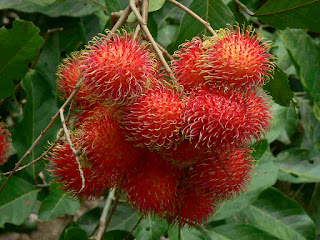Etymology
The name 'rambutan' is derived from the Malay language word for rambut or "hair", a reference to the numerous hairy protuberances of the fruit, together with the noun-building suffix -an. In Vietnam, it is called chôm chôm (meaning "messy hair") due to the spines covering the fruit's skin.
Origin and distribution
Rambutan is native to tropical Southeast Asia and commonly grown throughout Indonesia, Malaysia, Thailand and the Philippines. It has spread from there to various parts of Asia, Africa, Oceania and Central America.
Although its precise natural distribution is unknown, it is thought to have originated on the Malay peninsula. The earliest historical record of rambutan trees show that they were cultivated by the Malayan jungle tribes around their temporary settlements, a practice followed to date. The widest variety of cultivars, wild and cultivated, are still found in Malaysia.
Description
It is an evergreen tree growing to a height of 12–20 m. The leaves are alternate, 10–30 cm long, pinnate, with three to 11 leaflets, each leaflet 5–15 cm wide and 3–10 cm broad, with an entire margin. The flowers are small, 2.5–5 mm, apetalous, discoidal, and borne in erect terminal panicles 15–30 cm wide.
Rambutan trees can be male (producing only staminate flowers and, hence, produce no fruit), female (producing flowers that are only functionally female), or hermaphroditic (producing flowers that are female with a small percentage of male flowers).
The fruit is a round to oval single-seeded berry, 3–6 cm (rarely to 8 cm) long and 3–4 cm broad, borne in a loose pendant cluster of 10–20 together. The leathery skin is reddish (rarely orange or yellow), and covered with fleshy pliable spines, hence the name, which means 'hairs'. The fruit flesh, which is actually the aril, is translucent, whitish or very pale pink, with a sweet, mildly acidic flavor very reminiscent of grapes.
Production
It is a popular garden fruit tree and propagated commercially in small orchards. It is one of the best-known fruits of Southeast Asia and is also widely cultivated elsewhere in the tropics including Africa, the Caribbean islands, Costa Rica, Honduras, Panama, India, Indonesia, the Philippines, and Sri Lanka; it is also produced in Ecuador where it is known as achotillo and on the island of Puerto Rico. Thailand is the largest producer from Surat Thani Province. Rambutan production is increasing in Australia and, in 1997, was one of the top three tropical fruits produced in Hawaii.



No comments:
Post a Comment